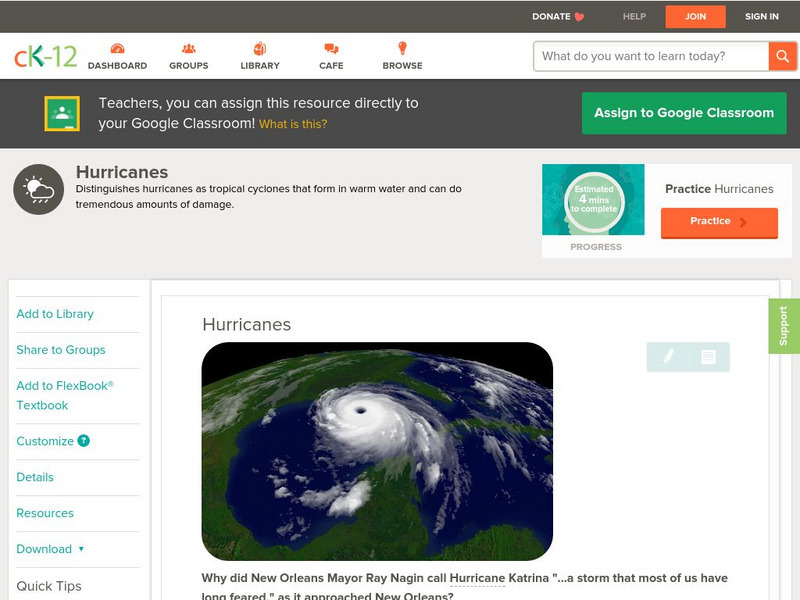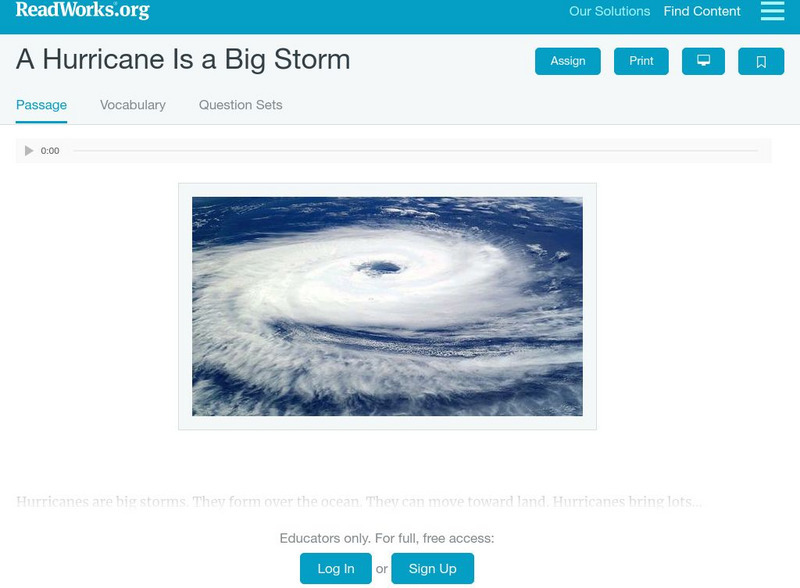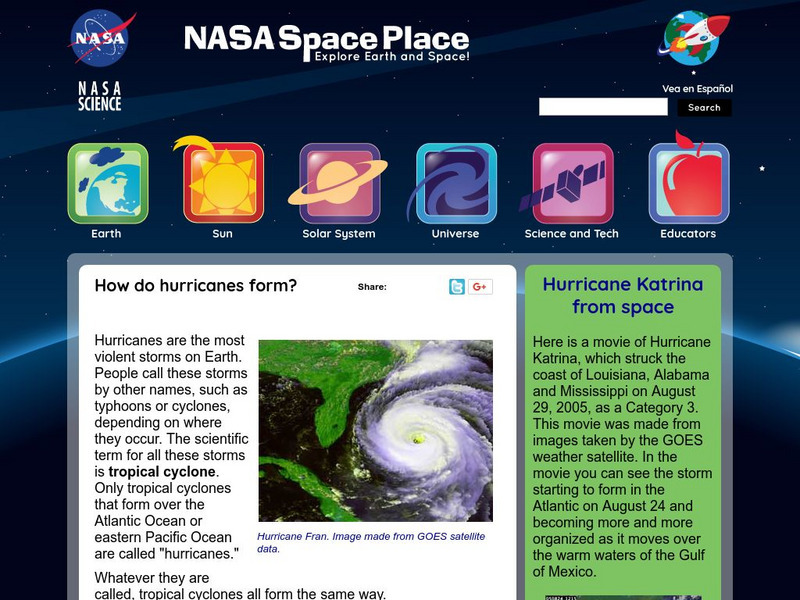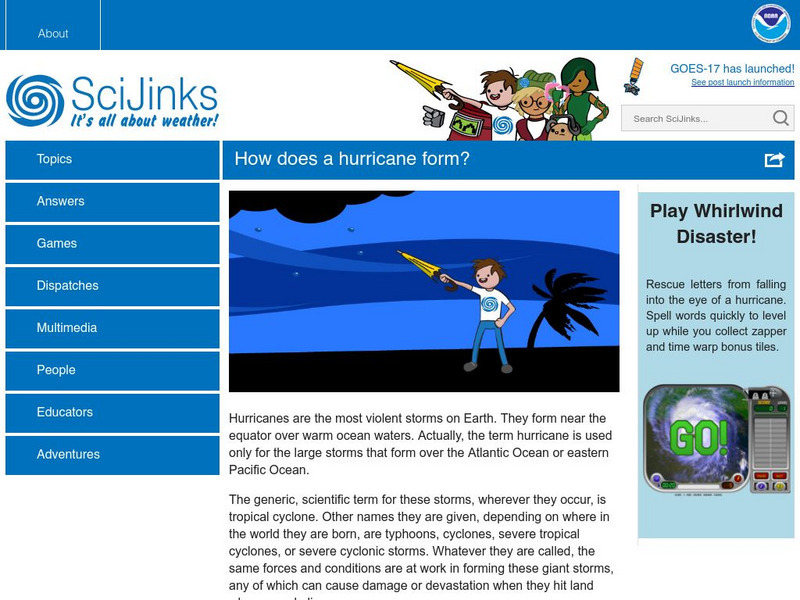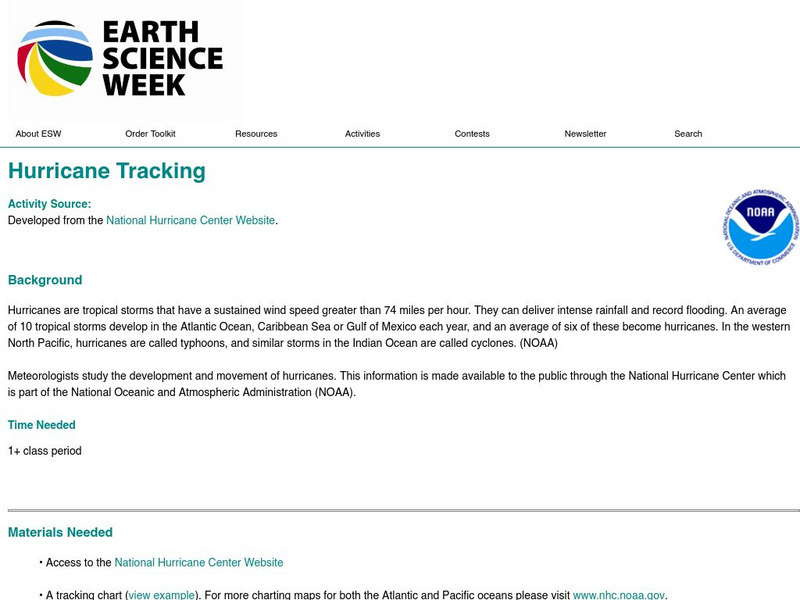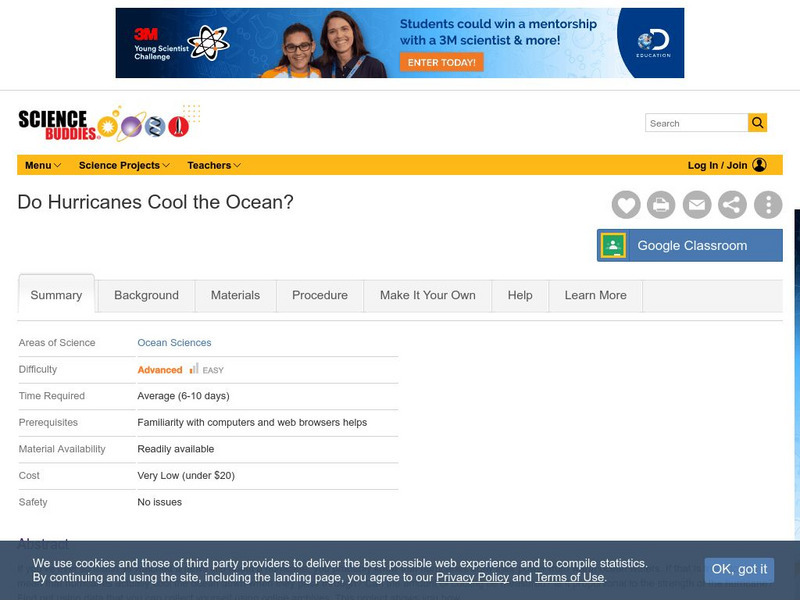Hi, what do you want to do?
Science Struck
Science Struck: Interesting Facts About Hurricanes
An ebook (with some embedded ads) that describes the characteristics and behavior of hurricanes, which are really the same phenomenon as typhoons and cyclones, and the damage caused by them.
University Corporation for Atmospheric Research
Ucar: Hurricane Safety
If you live in an area that is affected by hurricanes, it is important that you and your family create a plan for what to do in a hurricane, and pull together an emergency supply kit.
A&E Television
History.com: Hurricane Katrina: 10 Facts About the Deadly Storm and Its Legacy
Hurricane Katrina, the tropical cyclone that struck the Gulf Coast in August 2005, was the third-strongest hurricane to hit the United States in its history at the time. With maximum sustained winds of 175 mph, the storm killed a total...
eSchool Today
E School Today: Your Cool Facts and Tips on Hurricanes
Do you know what was the most destructive hurricane? Provides an explanation of a hurricane while exploring how they form, how they are measured and classified, effects, and how they get their names.
CK-12 Foundation
Ck 12: Earth Science: Hurricanes
[Free Registration/Login may be required to access all resource tools.] Describes how a hurricane forms and its effects.
Read Works
Read Works: A Hurricane Is a Big Storm
[Free Registration/Login Required] An informational text about hurricanes. A question sheet is available to help students build skills in reading comprehension.
Science Struck
Science Struck: Famous Hurricanes of the World
Describes famous hurricanes that have struck in the Northern Hemisphere since 1900, the regions affected, the intensity of the storms, and the extent of damage each caused. The hurricanes are organized in sequential order.
University Corporation for Atmospheric Research
Ucar: Where Do Hurricanes Form
If you are looking for a hurricane, head to the tropics just north and south of the equator.
University Corporation for Atmospheric Research
Ucar: Make a Hurricane
The temperature of the sea, moisture in the air, and high winds all play a role in making a hurricane stronger or weaker. Drag the hurricane over the ocean to see what happens.
Ready
Ready: Kids: Hurricanes
This resource explains hurricanes, are you at risk, as well as what you should do to protect yourself before, during, and after a hurricane.
A&E Television
History.com: Hurricane Katrina
Early in the morning on August 29, 2005, Hurricane Katrina struck the Gulf Coast of the United States. While the storm itself did a great deal of damage, its aftermath was catastrophic Levee breaches led to massive flooding, the federal...
Extreme Science
Extreme Science: Hurricanes
Whether you know it as hurricanes, typhoons, or cyclones, these dangerous storms are described in this article.
Science Education Resource Center at Carleton College
Serc: Hurricanes
Nine learning modules for students to study hurricanes using satellite imagery and visualizations, and participate in some hands-on experiments. They'll also explore over 150 years of storm data to find out when and where these storms...
NASA
Nasa: The Space Place: How Do Hurricanes Form?
This resource explores how hurricanes form and why they are called tropical cyclones. Images and illustrations are provided supporting this information.
National Institutes of Health
Niehs: Hurricane Katrina
When Hurricane Katrina hit the Gulf Coast area, NIEHS scientists and physicians were sent to assist with relief efforts. Provided is a helpful packing list and useful suggestions so you can help your family in case of an emergency or to...
NASA
Nasa: Sci Jinks: How Does a Hurricane Form?
This tutorial illustrates how hurricanes form from the moment they begin as a tropical disturbance to the point when they make landfall.
American Geosciences Institute
American Geosciences Institute: Earth Science Week: Hurricane Tracking
Students track and plot hurricanes paths for study.
University Corporation for Atmospheric Research
Ucar: Hurricanes
A strong hurricane can spell disaster. These huge storms are the most powerful of all weather systems. Learn about how they form and the impacts they can have.
Louisiana Department of Education
Louisiana Doe: Louisiana Believes: English Language Arts: Grade 4: Hurricanes
Fourth graders learn about hurricanes and their impact on Louisiana as well as how historical accounts reflect the culture of Louisiana and give insight into historical events. This set builds on storytelling as a way to transmit...
Science Buddies
Science Buddies: Do Warmer Seas Make Stronger Hurricanes?
We've all heard that hurricanes draw their immense power from warm ocean waters. Of course, many factors contribute to the formation and growth of a hurricane, but can we expect to find that the warmer the water, the stronger the...
Science Buddies
Science Buddies: Do Hurricanes Cool the Ocean?
If you've ever so much as watched a news clip about a hurricane, you probably know that hurricanes draw their power from warm ocean waters. If that is true, does it mean that hurricanes actually cool the ocean down when they pass...
NOAA
Noaa: Ncdc: Hurricane Katrina Information [Pdf]
Lots of information about the causes of Hurricane Katrina from a meteorology point of view is shared, as well as the data from the Hurricane and the impact the Hurricane had on the cities and towns that were affected.
NOAA
Noaa: National Hurricane Center: The Saffir Simpson Hurricane Scale
Read how hurricanes are rated on the Saffir-Simpson scale and check out the hurricane record for each level of the scale.
Other
St. Petersburg Times: Hurricane Andrew, After the Storm
Hurricane Andrew struck southern Florida on August 24, 1992. As these articles explain, residents still feel the impact of the storm ten years later on many levels - the psychological toll, the cost of insurance, and in the need to...
Other popular searches
- Hurricanes and Tornadoes
- Effects of Hurricanes
- Hurricanes Math Lessons
- Tracking Hurricanes
- Hurricanes in the Caribbean
- Formation of Hurricanes
- Hurricanes and Excel
- Hurricanes vs Tornado's
- Earth Science Hurricanes
- Plotting Hurricanes
- Hurricanes Poster
- Comprehension About Hurricanes







